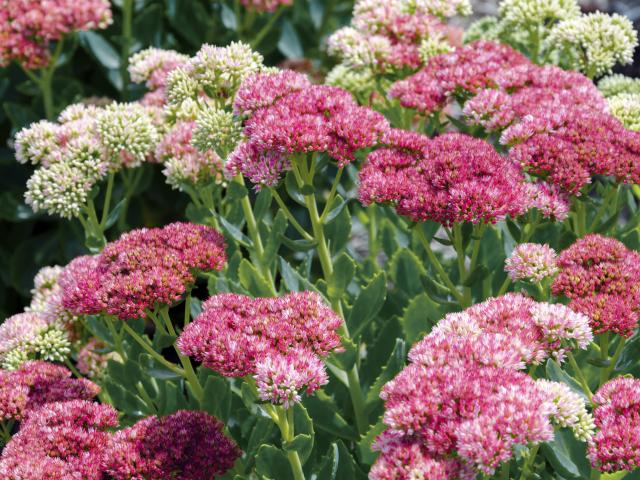Cheerful sedums are a delightful addition to an autumn garden. Their bright pink flowers and succulent green, grey or purple leaves light up the flowerbeds.
Sedums are also a good nectar source for butterflies and bees - and especially valuable in autumn when there are fewer plants in flower. Many cultivars flower from July/August to September/October. They are especially useful for butterflies and moths that are feeding up before hibernating. Most butterfly species in Britain spend the winter as egg, caterpillar or chrysalis. However, Brimstone, Comma, Peacock and Small Tortoiseshell hibernate as adult butterflies (as do some moths). The Red Admiral doesn’t enter a proper dormancy and will become active on warmer days even in mid-winter.
The large, flat flower heads of a sedum make good landing pads for insects and the nectar is easy to access from the masses of tiny stars that make up the heads.
Sedums are hardy perennials and like well-drained soil and a sunny spot, which also suits butterflies. The pink flowers are also a colour which is attractive to butterflies.
Their fleshy leaves are capable of storing water, allowing them to withstand periods of drought. The seedheads can be left in place over the winter and then the dead stems cut back in spring.
There are many sedums to choose from with variations in foliage and flower colour. The main one which is known to be very popular with butterflies is Iceplant or Butterfly Stonecrop Sedum spectabile. It has grey-green leaves with pinkish mauve flowers. This plant is probably one of the parents of the popular and robust hybrid S. Herbstfreude ‘Autumn Joy’. However, some people have reported that this is more attractive to bees than butterflies.

Others that are notable and have the RHS Award of Garden Merit (AGM), include S. telephium ‘Matrona’, ‘Karfunkelstein’ and ‘Purple Emperor’. ‘Matrona’ forms an 80cm mound and has rose-pink flowers from August to October. ‘Karfunkelstein’ is reddish-black with pale pink flowers from July to October. ‘Purple Emperor’ has purplish-black foliage with mid-pink flowers and was apparently named after the elusive butterfly.
Let me know which sedum you have found to be the most popular with butterflies.
Enjoy the beautiful autumn colours in your garden.
Happy Gardening!
The Secret Gardener
Note: Recently the upright forms with large succulent leaves and thick roots (such as Sedum spectabile) have been re-classified into their own genus – Hylotelephium (eg Hylotelephium spectabile), leaving Stonecrops, the creeping plants with small leaves, still classified as Sedum. However, the use of the old name seems to be ongoing.


